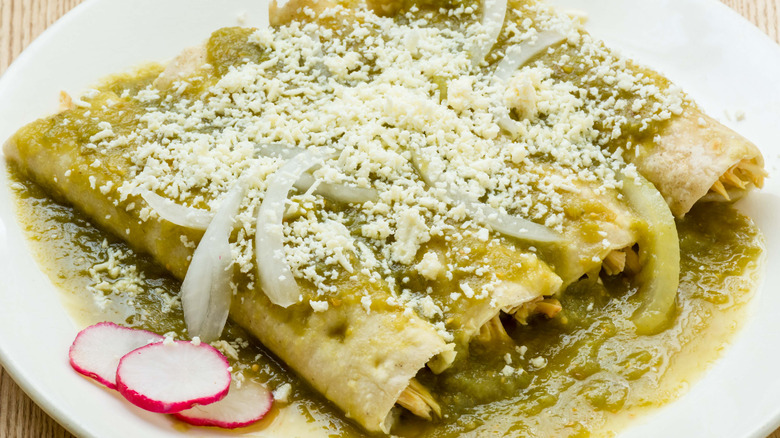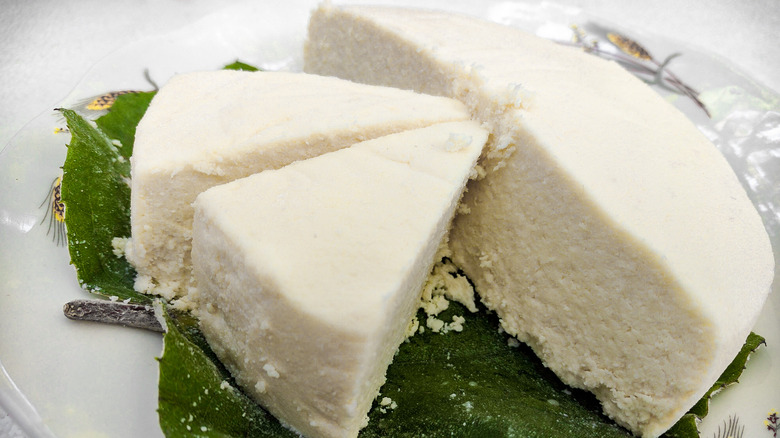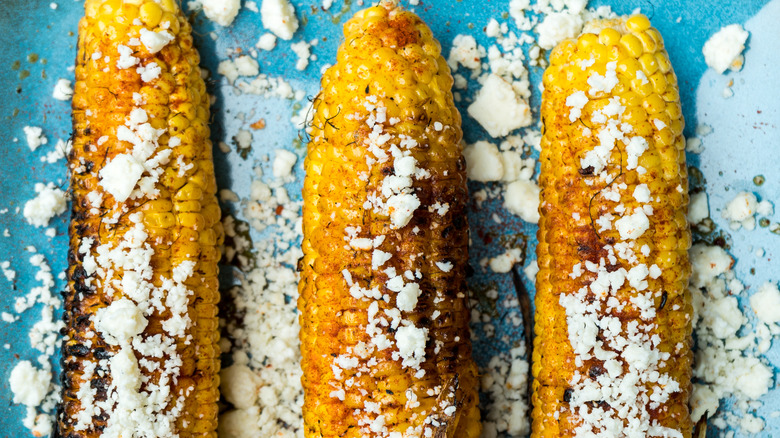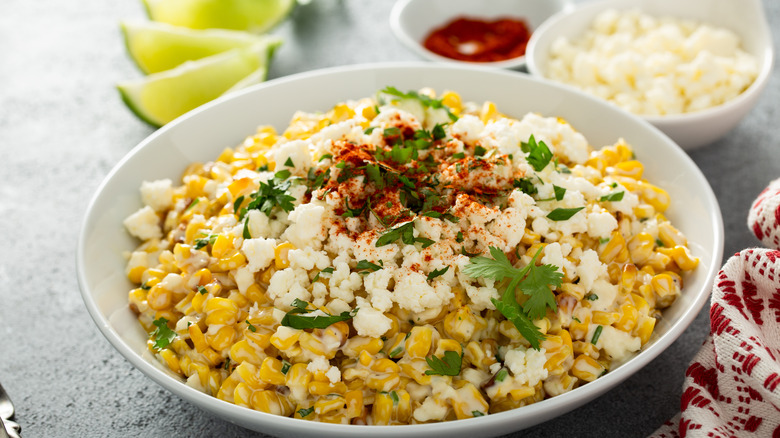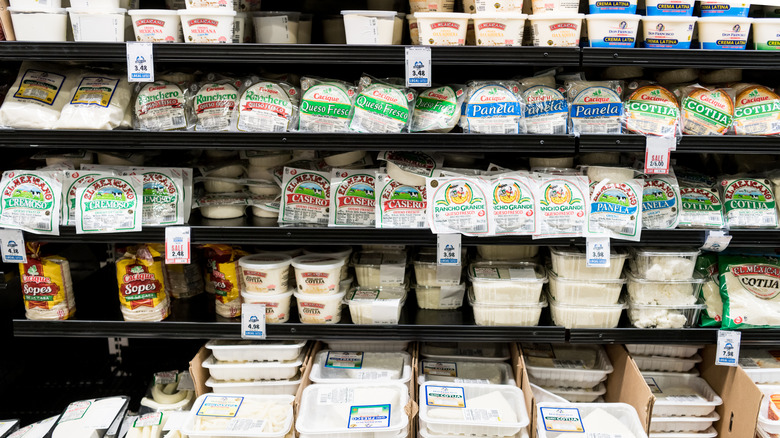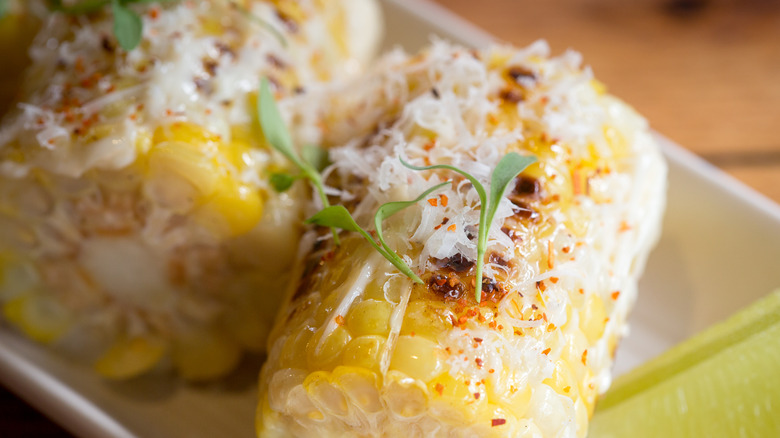What Is Cotija Cheese And What Does It Taste Like?
Cotija cheese is one of those ingredients that, if you haven't yet heard of it or had the chance to try it, has the potential to change your life for the better. You might have noticed Cotija cheese in a few places: on a menu at a Mexican restaurant, or alongside other refrigerated cheeses at your grocery store, like queso blanco.
Merriam-Webster defines Cotija cheese as "a hard, white, crumbly Mexican cheese made from cow's milk," and notes the term became popular somewhere around 1975. The word "Cotija" is a reference to the Cotija municipality in Michoacán, Mexico, from where the cheese originates. It is most often used as a crumbly topping in dishes like enchiladas, soups, or elote (Mexican street corn). But its uses certainly don't end there — this delicious and versatile cheese is the perfect way to add a little extra sparkle to a variety of dishes.
What is Cotija cheese?
Cotija cheese originates from Mexico, and is thought to have been created some 400 years ago. It is made using unpasteurized milk, salt, and rennet, and is aged for at least a year before being marketed (via Mexican Food Journal). According to Mexico Cooks, Cotija cheese has been given the Marca Colectiva designation in Mexico for its unique local production, similar to the designation given to real champagne produced in the Champagne region of France.
While you can find Cotija cheese in block form at the grocery store, the cheese is especially famous for its crumbly texture, meaning grating it over dishes is one of the ideal ways to use it. Mexican Food Journal likens the use of Cotija to Parmesan, in that it's sprinkled into dishes in small quantities in order to enhance their flavor. Cotija cheese is typically bright white or very pale yellow in color, with a relatively firm (and obviously crumbly) texture. It's a bit on the saltier side, but also has a milky, creamy taste and texture, so it's hard to put into a single category.
What does cotija cheese taste like?
This savory cheese has a salty-yet-milky flavor profile that can change over time, depending on how long it is aged. According to Bon Appetit, a shorter-aged (younger) Cotija cheese has a more feta-like texture. But as it ages, Cotija develops a sharper, firmer flavor profile and texture, which again is likened to Parmesan.
While there are some dishes that call for a generous amount of Cotija cheese (like elote or a dip inspired by it), it is not typically the base for a dish. Meaning: using it as a topping is a way to both enhance the savory flavors of your main dish and enjoy the unique flavor of Cotija itself. Bon Appetit also notes this cheese "has a distinct funk that can't be easily replicated." Despite this "funk," Cotija is nowhere near as pungent or distinct-tasting as say, a blue or goat cheese; it has a much milder flavor. It does have a significant salt content; Food Network found that Cotija has three times the sodium than a Mexican shredded cheese blend.
How to cook with cotija cheese
Because there are essentially two different "types" of Cotija cheese (young and soft, or aged and hard), there are a variety of ways to use it. Isabel Eats points out that unlike many other cheeses, Cotija cheese doesn't melt. Therefore, it is often used as a "finishing cheese" to top off a savory dish.
There are a bunch of tasty recipes that utilize Cotija cheese, including Mexican Street Corn or Elote. This particular dish is likely the most popular use of Cotija cheese, as its crumbly texture and savory flavor provides a creamy, salty, and mouthwatering accompaniment to the deliciously sweet corn and salty, tangy spices.
And while other popular, traditional Mexican dishes like tacos, enchiladas, and refried beans often see Cotija cheese sprinkled on top, it can definitely be used to complement non-Mexican dishes that could use a little extra salt or texture. Cotija cheese could be added to a veggie burger, or grace the top of an egg dish — it's used in our Starbucks Southwest Veggie Wrap copycat recipe. Even a hearty salad could benefit from a little sprinkle of Cotija on top!
Where to buy cotija cheese
Isabel Eats notes that Cotija is a fairly common cheese, which means it can be found "in many large grocery store chains and smaller Hispanic specialty grocers" throughout the country. That means that no matter where you are, you should be able to find Cotija cheese somewhere near you. Of course, if all else fails there's always the internet!
In major grocery stores, you'll likely find Cotija cheese in the refrigerated section with other cheeses. It will depend on your store's setup — sometimes Cotija cheese can be found in the refrigerated section alongside other artisanal cheeses sold by the block, other times it might be in a section dedicated to Mexican cheeses and other refrigerated ingredients. For example, you might find a small section showcasing Cotija cheese, queso blanco, and salsa.
If you have a Hispanic specialty store near you, definitely give it a try to see what kinds of Cotija they offer. Your local artisan cheese shop might have a small selection, too. If it seems difficult to find Cotija cheese in your local store, most large grocery stores and cheese-specific online retailers offer online delivery.
Other varieties of cotija cheese
As mentioned earlier, there's both young and aged Cotija cheese, which have different textures and flavor profiles. As far as retail is concerned, Cotija is typically available either pre-grated or as a full block that you can grate or crumble yourself.
Different regions produce Cotija cheeses with varying flavor profiles and textures, according to Mexican Food Journal, with the Michoacán style (salty, dry, hard rind and an easy crumble) being known as the "original Cotija." This is the style of Cotija that doesn't melt when heated.
However, the Jalisco variety of Cotija — while also dry and salty — can be used for grilling or pan-frying, meaning it will likely soften with some added heat. It doesn't crumble as easily as the traditional Michoacán style.
There are also the Querétaro and Chiapas varieties of Cotija, which are also well-suited for pan-frying. "Querétaro style cotija is unique in that it is covered with a paste made from dried chiles, vinegar, and garlic to preserve it, which gives it a distinct color and taste," Mexican Food Journal explains. This is one of the fresher and softer varieties of Cotija cheese, with the Chiapas variety following closely behind. However, Chiapas Cotija has a milder flavor and less crumbly texture.
